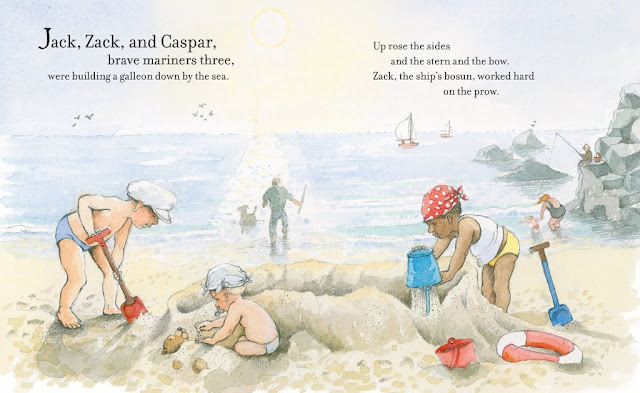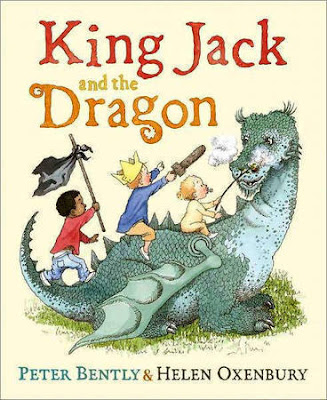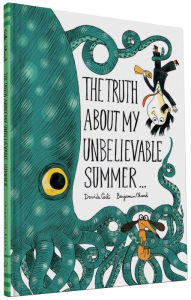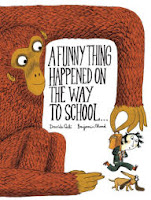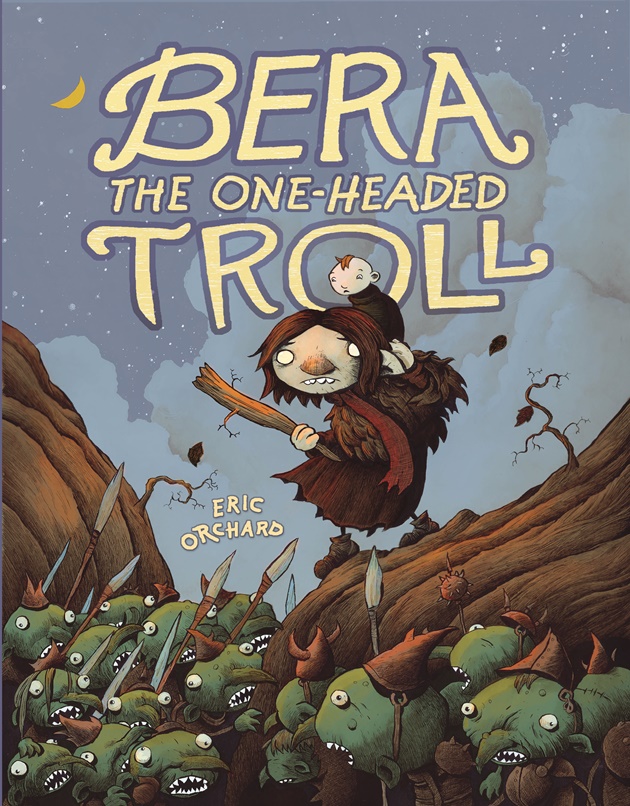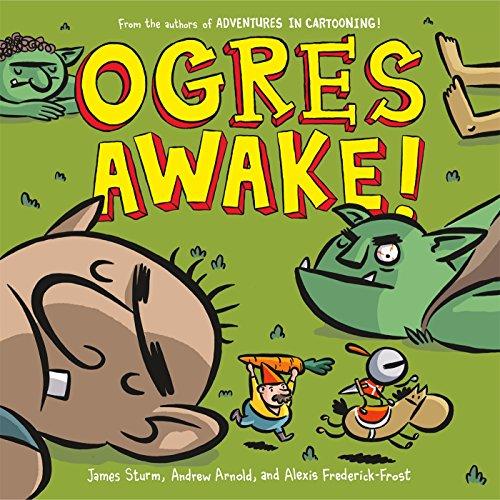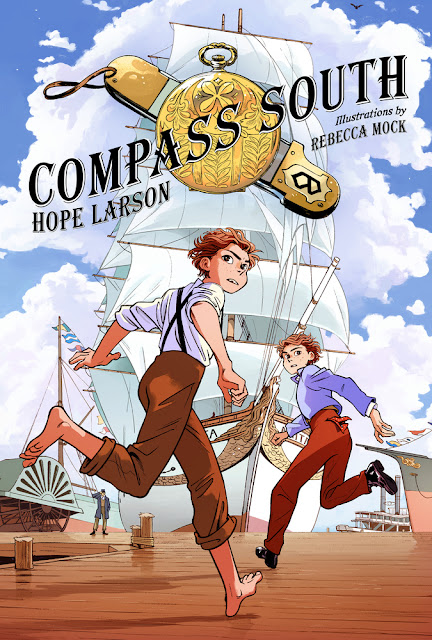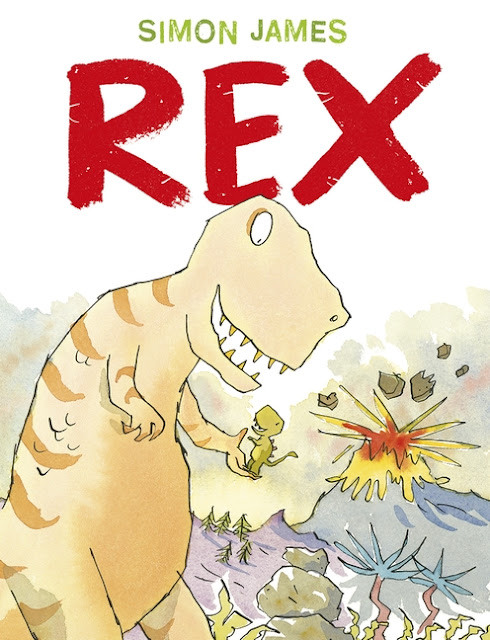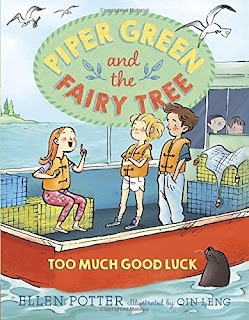new posts in all blogs
Viewing: Blog Posts from the Bookseller category, Most Recent at Top [Help]
Results 51 - 75 of 16,979
How to use this Page
You are viewing the most recent posts from blogs in the Bookseller category in the JacketFlap blog reader. These posts are sorted by date, with the most recent posts at the top of the page. There are hundreds of new posts here every day on a variety of topics related to children's publishing. Scroll down through the list of Recent Posts in the left column and click on a post title that sounds interesting. Click a tag in the right column to view posts about that topic. You can view all posts from a specific blog by clicking the Blog name in the right column, or you can click a 'More Posts from this Blog' link in any individual post.
Fiona Robinson brings her talents as a picture book author and illustrator (see below for reviews of two of her books that are favorites of mine) to a picture book biography with Ada's Ideas: The Story of Ada Lovelace, the World's First Computer Programer. Last year was the 200th anniversary of the birth of Ada Lovelace, daughter of Lord Byron. Her mother, Anne Isabella Byron, herself a gifted mathematician who was tutored at home, receiving an education equal to that of a man at Cambridge, ended her marriage after two years and kept Ada from her father, raising and educating her alone. 
Robinson details Ada's childhood, working in the changes brought about by the Industrial Revolution. It seems that touring factories where the machines that were "thrilling modern wonders," became a popular pastime for the wealthy. Ada's mother took her on these tours where her "imagination whirred along with the powerful engines! And her mind, so well trained by her many lessons, began to invent!" Ada called one of her ideas for a flying mechanical horse "flyology." Ada even signed off a letter to her mother, "Your Affectionate Carrier Pigeon," causing her mother to fear that some of her father's madness evident in his daughter. But, as Robinson writes, Ada's "imagination could not be confined by math, because Ada was starting to find her own sort of poetical expression . . . through math!"

Robinson shares the same details that Laurie Wallmark, herself a teacher of computer science, does in her book Ada Byron Lovelace and the Thinking Machine, while bringing a more poetic tone to her writing as well as a more imaginatively creative style to her illustrations. In fact, click over and read - or even just look at the pictures of Robinson's artistic process - in her interview at Design of the Picture Book. 
 Robinson takes Ada through her adolescence, her meeting with Charles Babbage and his Difference Engine and into her young adulthood and marriage. Robinson spends several pages writing about the Analytical Engine, making links to the Jacquard Loom when describing the the hole-punched cards (that also make up the fantastic endpapers and case of this book, as seen above) that Babbage fed into the machine to calculate sums. I was Ada who figured out the algorithm that would be punched into the cards, which Robinson illustrates with a very clever page of maze-like swirls and a list of instructions on how readers should navigate the swirls to find the treasures in the maze, which is VERY cool and an analogy that I could grasp.
Robinson takes Ada through her adolescence, her meeting with Charles Babbage and his Difference Engine and into her young adulthood and marriage. Robinson spends several pages writing about the Analytical Engine, making links to the Jacquard Loom when describing the the hole-punched cards (that also make up the fantastic endpapers and case of this book, as seen above) that Babbage fed into the machine to calculate sums. I was Ada who figured out the algorithm that would be punched into the cards, which Robinson illustrates with a very clever page of maze-like swirls and a list of instructions on how readers should navigate the swirls to find the treasures in the maze, which is VERY cool and an analogy that I could grasp.
I can't wait to share this book, and Wallmark's, with my second graders who do reports on people and animals who are heroes every year! Robinson's illustrations and text are engaging and even better, comprehensive.
My favorite picture books by Fiona Robinson:
More about Ada Lovelace:
Source: Review Copy
Jonny Duddle is the illustrator and author of some gorgeously illustrated picture books, all of which I have read, a couple of which I have reviewed (see below.) Now, Duddle takes his friendly pirate family from picture book The Pirates Next-Door and spins longer yarns with them and former, pirate loving neighbor and resident of the tiny town of Dull-on-Sea, Matilda in his debut chapter book series The Jolley-Rogers. Besides being fun and fascinating pirate packed mysteries, the books in this series are just plain gorgeous and perfectly suited to Duddle's richly detailed illustrations. The trim size is a bit larger than the traditional chapter book with parts of the title printed in metallic ink. And the interior illustrations are remarkably generous with images on almost every page, often flowing across two pages!

In the first book, The Jolley-Rogers and the Ghostly Galleon, the Dull-on-Sea Museum is burgled, causing all the towns folk to rush to hide and/or secure their valuables. Matilda sends a message in a bottle to her pal, Jim Lad, and the Jolley-Rogers turn their ship, the Black Hole, toward town. Once they dock, they get into their amphibious vehicle and get down to solving the mystery of the missing treasure.

In this first book, a crew of ghost pirates led by Cap'n Twirlybird, looking for a long lost key, the story of which is sung as a chantey by Grandpa Rogers. If you have read any of his picture books, you know that Duddle is great with a rhyme. Interestingly enough, Tilly's neighbor, the almost 100 year old Miss Pinky, just happens to have a strange key that her brother found in 1944 on the beaches of Normandy amidst the explosions. Once they have the key, Jim Lad and Tilly have to face the ghostly pirates and save their souls by unlocking a trunk that they don't want unlocked...
In the second book in the series, The Jolley-Rogers and the Cave of Doom, the crew of the Black Hole find themselves under the spell of three sea hags, bewitched by a magical haul of treasures and Matilda is the only person who can help them!
Books 2 & 3 in The Jolley-Rogers Series
Jonny Duddle's Pirate picture books
featuring the Jolley-Rogers
Source: Review Copy
In 2011 we first met Jack, Zack and Caspar, three boys with a creativity that was surpassed only by their imagination. In King Jack and the Dragon, written by Peter Bently and illustrated by the marvelous Helen Oxenbury, the three spend the day building a castle then defending it from dragons and giants until it's time to go home.
In Captain Jack and the Pirates, Jack, Zack and Caspar are on the beach, "brave mariners three," building a "galleon down by the sea." Sand, sticks and somebody's shirt come together and the three set sail. They head out to sea, "hungry for glory and enemy booty," but a tropical gale scuppers their plans.

Abandoning ship, the three agree to explore, but must rescue little Caspar when he is captured by the pirates. They slip into the hideout and find treasure galore! The pirate hideout is actually cabana where mom and dad have been preparing afternoon tea, including three ice cream cones and a happy ending. Bently's rhyming text can almost be sung like a sea chanty and the adventure that he creates for the boys - imagined and read - is wonderful. Oxenbury, a favorite of mine, is a gifted illustrator who is especially skilled at bringing preschool aged children and the natural world to the page. As in King Jack and the Dragon, the illustrations alternate between color and monochrome, Oxenbury's lush watercolor and pencil perfectly balance the real world experiences of the boys and the imaginary world that they create. While it was almost five years between books, I will happily wait for a third adventure with Jack, Zack and Caspar!
Source: Review Copy
It's a very good time to be an emerging reader, especially because Tom Angleberger and Cece Bell, celebrity super couple of the kid's book world, have teamed up again! This time, the duo bring their weird, wacky senses of humor to Inspector Flytrap, a series of books featuring a hard boiled detective who just happens to be a Venus Flytrap.
Being a detective - and a plant - has its challenges. Happily, Inspector Flytrap (who is constantly correcting people who refer to him as Mr. Flytrap) has an assistant, Nina, who puts him on a skateboard and does all the driving whenever they need to get to a crime scene quickly. Nina is a goat, which has a few drawbacks since she will eat anything. As the Inspector says, "it's scary to have an assistant who eats everything, especially for a plant like me." Nina also has a standard flip response to almost everything, which is, "Big deal."

The first Big Deal case (no small deal cases for him) readers get to see Inspector Flytrap tackle comes from Lulu Emu, a museum employee who take the Inspector and Nina into the Top Secret Art Lab to help solve the mystery of the strange yellow blob on a newly discovered, extremely rare painting by Leonardo Da Vinci. In fact, this happens to be the only flower painting Da Vinci every created. Nina, being Nina, licks the yellow blob and notes that it tastes salty. The Inspector soon cracks the case, the solution of every case getting a full page, multi-panel comic strip. Turns out, Da Vinci sneezed on his own painting, leaving a booger on the canvas. Lulu Emu is disappointed as she thought it was a secret message, a la a Don Brown novel, but her coworker in charge of the museum's Gallery of Mucus is thrilled!
The gags and goofiness in Inspector Flytrap continue throughout the four chapters of the novel in which the Inspector solves three cases and spends one chapter eating lunch at the restaurant where he first met Nina. Inspector Flytrap takes a lot of calls, and one of my favorite jokes in the book comes when he gets a call or two from a fly with a case. Also, Nina usually eats evidence or missing items that have been found, which is also hilarious. There is also a really great range of animals in the Inspector Flytrap series, including a sloth and a dodo, two favorites of mine. I ordered this series for my library before I even read them and now, having read the first book, I plan to order a couple more sets - the Inspector Flytrap books are going to be hot, hot, hot!
Book 2 in the Inspector Flytrap series:
Coming in January 2017!
Source: Review Copy
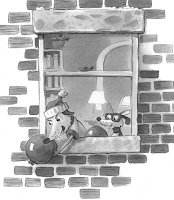 The Infamous Ratsos is a rare little chapter book written by Kara LaReau and illustrated by Matt Myers. I say rare because it's not often that I get to read a book at this reading level that feels like a real chapter book, rather than a leveled reader. The Infamous Ratsos is written in simple but colorful language and is perfect for newly independent readers or even for a read out loud!
The Infamous Ratsos is a rare little chapter book written by Kara LaReau and illustrated by Matt Myers. I say rare because it's not often that I get to read a book at this reading level that feels like a real chapter book, rather than a leveled reader. The Infamous Ratsos is written in simple but colorful language and is perfect for newly independent readers or even for a read out loud!
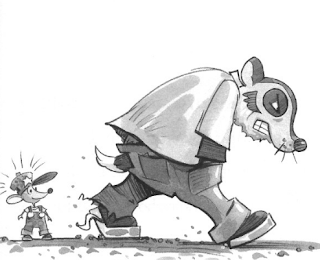 Louie and Ralphie Ratso are two brothers who hang tough, no matter what. They want to be just like their dad, Big Lou, who drives a truck and a forklift and sometimes a snow plow. There are two kinds of people in this world, says Big Lou, "Those who are tough and those who are soft." Louie and Ralphie get the message and want to make their dad proud, especially since they are trying hard not to think about Mama Ratso, who's been gone for a little while now.
Louie and Ralphie Ratso are two brothers who hang tough, no matter what. They want to be just like their dad, Big Lou, who drives a truck and a forklift and sometimes a snow plow. There are two kinds of people in this world, says Big Lou, "Those who are tough and those who are soft." Louie and Ralphie get the message and want to make their dad proud, especially since they are trying hard not to think about Mama Ratso, who's been gone for a little while now.
 Louie, who considers himself the smart one, confuses being tough with being mean, which gets the brothers into a lot of sticky situations that don't go as planned. Stealing a hat from the biggest, baddest guy on the playground makes the brothers heroes. Turns out that Chad Badgerton stole the hat from Tiny Crawley on the bus that very morning. The brothers are praised for stopping a bully. And trying to slip a homemade sandwich filled with disgusting pickled foods to the new girl only ends up making the homesick rabbit feel better, as the pickles remind her of her nana.
Louie, who considers himself the smart one, confuses being tough with being mean, which gets the brothers into a lot of sticky situations that don't go as planned. Stealing a hat from the biggest, baddest guy on the playground makes the brothers heroes. Turns out that Chad Badgerton stole the hat from Tiny Crawley on the bus that very morning. The brothers are praised for stopping a bully. And trying to slip a homemade sandwich filled with disgusting pickled foods to the new girl only ends up making the homesick rabbit feel better, as the pickles remind her of her nana.
More mess-ups ensue, and they get funnier as they go. Finally, Big Lou gets a letter about the boys's behavior. They try to deny being helpful, thoughtful, friendly and kind, saying they want to be TOUGH just like their dad, not softies. This gives Big Lou pause and the boys have a good talk, a cuddle and even a little cry. From then on, all the Ratsos are helpful guys. Like Big Lou says, "Life is tough enough, we might as well try to make it easier for one another, whenever we can."
Love these rats, the fantastic illustrations and the wonderful message to be found in The Infamous Ratsos.
Source: Review Copy
In early 2014 I reviewed the picture book Some Bugs, written by Angela Di Terlizzi and illustrated by Brendan Wenzel. A fantastic, rhyming book, Wenzel's illustrations were unforgettable, calling to mind Eric Carle with a goofy undercurrent. I have been following Wenzel's career since then and am so excited to be reviewing the first picture book written an illustrated, They All Saw a Cat. 
They All Saw a Cat is a story of observation and perspective, the idea for the book coming to Wenzel several years ago when he was teaching art classes in Nepal, noting that, "if every kid in the classroom draws the exact same thing - say, a cat - they will come up with a unique image, depending on their perspectives on and experiences with cats, that puts the animal in a different, new light." They All Saw a Cat follows a cat as it walks through the world, each person and creature who sees the cat viewing it differently. They All Saw a Cat is simple and brilliant, living up to all the praise that has been heaped upon it (see the end of the review for details of the heaps of praise.)
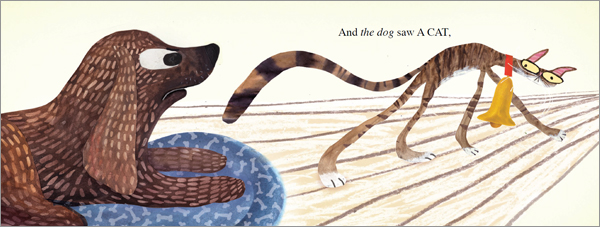
Wenzel's text in They All Saw a Cat is sleekly repetitive - read it out loud and you will probably find yourself instinctively singing the words. The book begins, "The cat walked through the world, with its whiskers, ears and paws . . ." To the child, the cat is all sweet, big eyes and happiness. To the dog, the cat is skinny and suspicious, slinking past. And to the fox? The cat is a puffy, mouthwatering, marshmallow of a morsel.
 They All Saw a Cat twist and turns, just like the titular cat. How the cat looks to prey and predators, how the cat looks to a bee and to a worm, a flea and a bat, are just a few of the perspectives we are treated to as the cat walks through the world. The climax of the book finds the cat, a patchwork of all the perspectives. In the final pages, the cat approaches a pond, glimpsing his reflection, the text asking, "imagine what it saw?"
They All Saw a Cat twist and turns, just like the titular cat. How the cat looks to prey and predators, how the cat looks to a bee and to a worm, a flea and a bat, are just a few of the perspectives we are treated to as the cat walks through the world. The climax of the book finds the cat, a patchwork of all the perspectives. In the final pages, the cat approaches a pond, glimpsing his reflection, the text asking, "imagine what it saw?"
As the article in Publisher's Weekly from 2014 revealed, They All Saw a Cat was part of an eight publisher bidding war that was won by Chronicle Books, earning Wenzel a two-book deal and a six-figure deal. As the press material that came with They All Saw a Cat revealed, an editor from one of the losing houses proclaimed, "You guy have the next freakin' Eric Carle." My time working as an assistant to an agent was coming to an end just as Brendan Wenzel was introduced to him by Angela Di Terlizzi. Having witnessed a few bidding wars for manuscripts, I can only imagine what it was like in the office on the day that Chronicle prevailed. It's not often that a talent - and book - like Wenzel's comes along, and, as Ginee Seo, children's publishing director at Chronicle said, "I feel a bit embarrassed using a cliché, but as soon as I saw the proposal , I felt I was looking at an instant classic. . . the book is so intelligent and well thought-out that form the very first words and images you know you're in the hands of someone who is confident and knows what he is doing. Brendan's writing is spare and has a rhythm and pacing that is unusual for an artist to achieve. And his art has a sense of movement that is just beautiful. As an editor, I knew immediately that this was really rare."
Source: Review Copy
When the blackberries hang
swollen in the woods, in the brambles
nobody owns, I spend
all day among the high
branches, reaching
my ripped arms, thinking
of nothing, cramming
the black honey of summer
into my mouth; all day my body
accepts what it is. In the dark
creeks that run by there is
this thick paw of my life darting among
the black bells, the leaves; there is
this happy tongue.
- August by Mary Oliver
View all posts tagged as Poetry Friday at Bildungsroman.
View the roundup schedule at A Year of Reading.
Learn more about Poetry Friday.
The premise of David Cali and Benjamin Chaud's trilogy is simple, circular and deeply satisfying. Beginning in 2014 with I Didn't Do My Homework Because . . ., Cali and Chaud have taken readers on one detail packed adventure after another, starring our young hero in his pinstriped suit, red necktie and red socks, and his faithful, bug-eyed dachshund and his bespectacled, clever teacher.

The Truth About My Unbelievable Summer begins with the inevitable question upon returning to school, "So, what did you do this summer?" Our hero responds, "Well, you may not believe this, but . . . " On a visit to the beach, he finds a message in a bottle and inside it is a treasure map! But, a magpie swoops in and pecks it out of his hands and the adventure begins. There are pirates, submarines and time travel that finds our hero floating down the Seine in his submarine as a bucket of slop is tossed on his head as he passes under the bridge in front of Notre Dame. Turns out he didn't time travel - he just happened onto a movie set.

There are libraries, hot air balloons, the Taj Mahal, mummies, pyramids and the Great Wall. And Yetis. But I don't want to give the whole story away. The final page ends, circling back to the start of the story, with a nice little reveal that brings the teacher back into the story. Three is a nice number, but I wouldn't mind one or two more books featuring our imaginative, well dressed hero and his dog . . .
The first two books in the trilogy and . . .
A Doodle Book of Excuses!! How cool is that?
 Eric Orchard is the creator of Maddy Kettle, Book 1: The Adventure of the Thimblewitch in which eleven-year-old Maddy heads off on a quest after her bookstore-owning parents are turned into kangaroo rats by spider goblins. In Bera the One-Headed Troll, tables are turned as Bera, a troll, finds herself with a human infant she is trying to return to its parents. Bera's spare world is one of nighttime - if sunlight touches her, she will turn to stone - rendered in faded oranges and browns. And it is filled with ghosts, ogres with more than one head, benevolent rats, evil mermaids and hedgehog wizards that are a little creepy, a little goofy and entirely fascinating.
Eric Orchard is the creator of Maddy Kettle, Book 1: The Adventure of the Thimblewitch in which eleven-year-old Maddy heads off on a quest after her bookstore-owning parents are turned into kangaroo rats by spider goblins. In Bera the One-Headed Troll, tables are turned as Bera, a troll, finds herself with a human infant she is trying to return to its parents. Bera's spare world is one of nighttime - if sunlight touches her, she will turn to stone - rendered in faded oranges and browns. And it is filled with ghosts, ogres with more than one head, benevolent rats, evil mermaids and hedgehog wizards that are a little creepy, a little goofy and entirely fascinating.

Bera is the troll with one head is the official pumpkin gardner of the Troll King. Living on a tiny island in a secret cove with just her owl, Winslowe, and her the ghost of Great-Great-Great-Great-Great-Great-Aunt Dota, who resides in a jar, she is happy with her quiet life. As she heads back to her house after the annual pumpkin harvest, she hears crying and finds the mermaids playing keep away with a crying baby in a cauldron.
Rescuing the baby from the mermaids, Bera faces another challenge when she receives the rare visitor at her door, the Troll King's former Head Witch, Cloote. Cloote has been banished, but she hopes to win her place back by using the human baby as part of a spell to create a hideous monster. Determined to get the baby back to the human village, Bera and Winslow leave the island for the first time ever and head into the woods in search of a legendary troll hero.
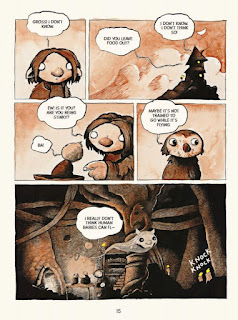
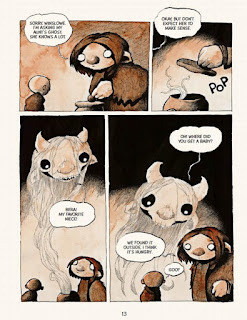
Bera, Winslowe and the baby in the cauldron are let down, betrayed and half-helped by one troll after another (one with two heads and one with three, just so you know there is a reason why Bera is referred to as a one-headed troll.) The raft of monsters and dangers in Bera the One-Headed Troll are wonderfully, gently menacing and Bera faces them all with quiet determination, much like Nanna the Great, an ancient troll legend who is happily turning into a hill. The climax of Bera the One Headed Troll, and the ending, are great, but honestly, I was happy trailing behind Bera, Winslowe and the baby as they wandered the forest throughout the night. I would love to see this trio again, but until then I'm getting my hands on a copy of Maddy Kettle!
Source: Review Copy
Ogres Awake! is the third book in the Adventures in Cartooning Jr. series (the mini-me of the Adventures in Cartooning series)and, as with Sleepless Knight and Gryphons Aren't So Great, authors Sturm, Arnold and Frederick-Frost present yet another silly story as the manic Knight and his steed, Edward, rush headlong into a new adventure. As always, the endpapers provide readers with instructions on how to draw the characters from the story. From high atop a parapet where the Knight is playing fetch with Edward, the duo discover that what they thought was thunder is the snoring of ogres, one of whom is using a sheep for a pillow. Ready for a battle, the Knight and Edward gallop off to the King, who is calmly reading a comic book, naturally. This day has been foreseen - a plan is in place!
What is the plan? You just have to read Ogres Awake! to find out! But, the illustrations - and garden gnomes - just might give you a clue or two...
Source: Review Copy
Compass South is the fantastic first adventure in the Four Points series of graphic novels written by Hope Larson and illustrated by Rebecca Mock. As I finished reading this book, I felt like I had read a complete novel, there are so many details, world building and character diveristy in this book. In fact, I was reminded of S.E. Grove's trilogy that begins with The Glass Sentence, although Larson's book is set firmly - so far - in real, not an alternative, historical landscape. Mock's illustrations, which are filled with warm earth tones, packed with movement and energy. At times, I had to remind myself of which twin was which, but, in all fairness, this is a story with two sets of redheaded twins!

Set in 1860, Compass South begins with a prologue that explains how and why twins Alexander and Cleopatra Dodge made it from Ireland to New York City with two very special items - a compass and a pocket knife. Twelve years later, the only father they have ever known (but not their birth father) has disappeared and the twins have joined the Black Hook gang, stealing to survive. When Alexander gets caught, he and Cleopatra make a deal that sends them to New Orleans with Luther, a higher up in the Black Hook gang, close on their trail. Luther has been recruited by Felix Worley, also known as Lucky Worley, captain of the black ship, El Caleuche, to find the twins and relieve them of their heirlooms.

These threads alone are enough to keep Compass South moving at a fast pace, but Larson weaves in a few more threads that make the story even richer. Before boarding the train to New Orleans, Alexander sees an add offering a reward for the return of redheaded twins to their father, who went West to find his fortune five years earlier. Alex convinces Cleo to cut her hair so they can pose as Samuel and Jeremiah Kimball and make their way to San Francisco to collect the reward and find their father. Of course things don't go as planned, starting with a run in with red headed twin boys that lands Alex and Edwin back in jail and Cleo and Silas without a plan.
While it's a challenge at times to remember which twin is which, especially after Cleo cuts her hair, the hot head Alex is paired with Silas, who has a mysterious ailment that leaves him weak, while thoughtful Cleo ends up with Edwin, who shares Alex's temperament. I will tell you that the twin pairs both end up on ships, but what happens to them, where they end up and what Luther and Worley want with them, well, you'll just have to read to find out!
Source: Purchased
Compass South is the fantastic first adventure in the Four Points series of graphic novels written by Hope Larson and illustrated by Rebecca Mock. As I finished reading this book, I felt like I had read a complete novel, there are so many details, world building and character diveristy in this book. In fact, I was reminded of S.E. Grove's trilogy that begins with The Glass Sentence, although Larson's book is set firmly - so far - in real, not an alternative, historical landscape. Mock's illustrations, which are filled with warm earth tones, packed with movement and energy. At times, I had to remind myself of which twin was which, but, in all fairness, this is a story with two sets of redheaded twins!

Set in 1860, Compass South begins with a prologue that explains how and why twins Alexander and Cleopatra Dodge made it from Ireland to New York City with two very special items - a compass and a pocket knife. Twelve years later, the only father they have ever known (but not their birth father) has disappeared and the twins have joined the Black Hook gang, stealing to survive. When Alexander gets caught, he and Cleopatra make a deal that sends them to New Orleans with Luther, a higher up in the Black Hook gang, close on their trail. Luther has been recruited by Felix Worley, also known as Lucky Worley, captain of the black ship, El Caleuche, to find the twins and relieve them of their heirlooms.

These threads alone are enough to keep Compass South moving at a fast pace, but Larson weaves in a few more threads that make the story even richer. Before boarding the train to New Orleans, Alexander sees an add offering a reward for the return of redheaded twins to their father, who went West to find his fortune five years earlier. Alex convinces Cleo to cut her hair so they can pose as Samuel and Jeremiah Kimball and make their way to San Francisco to collect the reward and find their father. Of course things don't go as planned, starting with a run in with red headed twin boys that lands Alex and Edwin back in jail and Cleo and Silas without a plan.
While it's a challenge at times to remember which twin is which, especially after Cleo cuts her hair, the hot head Alex is paired with Silas, who has a mysterious ailment that leaves him weak, while thoughtful Cleo ends up with Edwin, who shares Alex's temperament. I will tell you that the twin pairs both end up on ships, but what happens to them, where they end up and what Luther and Worley want with them, well, you'll just have to read to find out!
Source: Purchased

By: Tanya,
on 8/19/2016
Blog:
Children's Book Reviews and Then Some
(
Login to Add to MyJacketFlap)
JacketFlap tags:
Graphic Novel,
summer,
TEEN,
Real Life Girl Stories,
Summer Stories,
Summer Camp Story,
TEEN: Graphic Novel,
auto/biography,
aauthor: Thrash,
Add a tag
Honor Girl is Maggie Thrash's graphic memoir that was released last year and garnered awards and attention. Thrash chronicles the summer at an all girls camp where, having just turned fifteen, she falls in love for the first time. 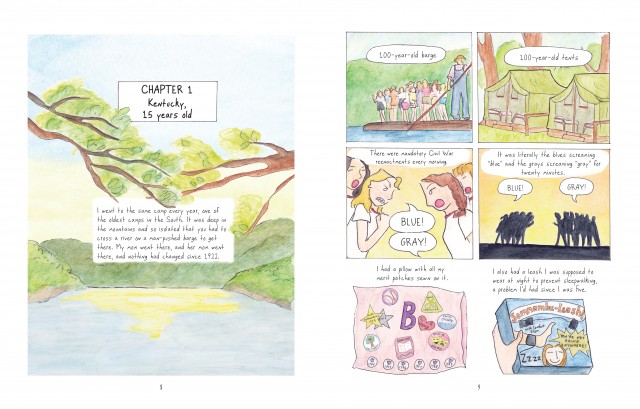
Maggie's mom and her grandma went to Camp Bellflower, set deep in the Kentucky Appalachians. Every summer, on the first night of camp, the Honor Girl, chosen on the last night of camp the summer before, is serenaded. At the end of the song, the Honor Girl's candle is used to light the candles of all the other campers. Thrash writes, "the criteria for Honor Girl were vague, with no particular definition. It was just the one who seemed, in an unmistakable way, to represent the best of us." Maggie is reading Harry Potter and the Goblet of Fire, her favorite Backstreet Boy is Kevin Richardson and she wears a leash at night that tethers her to her bed and keeps her from sleepwalking. The details of 15-year-old Maggie's life are mundane yet so genuinely real. Thrash is a gifted writer, making the quiet, everyday minutiae interesting and engaging. It's easy to get inside Maggie's head, feel what she feels, be fifteen.

Thrash tells the story of her first crush in all its thwarted, unconsummated, painful truth and it happens the way that I am sure most first loves happen, not the way they play out in fiction, especially YA fiction. Her crush, Erin, a 19-year-old counselor and astronomy major at college in Colorado, is not unknown to Maggie. But, she begins to feel differently about Erin after she gives her a routine lice check, running her fingers through Maggie's hair. Thrash uses wordless panels to illustrate this seen and as you scan you can feel something turning on, waking up, or beginning to slowly burn inside of Maggie. Thrash's skill as a visual story teller deepens the story immensely. Her illustration style is markedly different and less polished than many other graphic novels I have read. I'm still learning how to write about the art work in graphic novels and often look to other reviewers to help me shape my thoughts. I turned to Monica Johnson's review for The Comics Journal and found that her words describe Thrash's style (and the unique abilities that graphic novels have over other forms of writing) better than any I could find. Of Honor Girl Johnson writes,
Thrash certainly has drawing skills, but they're her own, and they're specifically savvy for the story she is telling. Her bare-bones line drawings colored with watercolor pencils seem to be channeled directly from her 15-year-old self. The drawings have the rawness and bright-eyed directness of the teenager depicted in them, who can't hide behind a catalog of romantic experience and mastery. This is part of the brilliance of the comic medium itself - the way images work in concert with the literal to tell a deeper, much richer story - and Thrash really hits the mark with it. The drawings are so believably vulnerable, which is maybe why her story feels so devastating.
Johnson's use of the word vulnerable is well placed, both in describing the illustrations, Maggie and Erin. Maggie and Erin have moments of vulnerability and missed opportunities. Erin is a counselor for the junior girls and Maggie is a senior girl, so they don't have many chances to run into each other alone. Then there is the fact that, in the eyes of the law, Erin is an adult and Maggie is a child, not to mention that, even though it's 2000, this is the South and a Christian girl's camp and being openly gay is not accepted. Maggie shares her feelings about Erin with friends and finds sympathy and support. They keep Maggie's secret and also nudge - or shove, in the way that teenage girls do - her toward Erin. In a meeting alone between Erin and Maggie, Maggie knows that Erin has made a move, and now it's up to her to make the kiss happen. But, filled with self doubt, she can't make it happen. She can't be that vulnerable.

While Honor Girl is a memoir about first love, it is also, if peripherally about being gay. Maggie is pulled aside by the head counselor who starts wide, telling her that her parents could sue the camp for statutory rape if her relationship with Erin goes any farther. Circling in for her target, she tells Maggie that it's, "her job to make sure everyone feels safe" because camp is a place where "girls can be totally innocent and free, maybe for the last time in their lives." Maggie assures her that she does feel safe, to which the response is, "Everyone else needs to feel safe, too. From you. . . Don't ruin it for everyone." The brutality of that moment is hard to read, especially because I think most of us, most women, experienced a time in our adolescence when an adult betrayed, disappointed or backhandedly told us not to be ourselves and those words go deep.
Thrash bookends Honor Girl with an event that takes place two years after her summer with Erin, but seems to play itself out the same as it did at Camp Bellflower. As Johnson says wisely in her review, "If you don't let people know that they are wanted, they will go away. Love relationships are fragile opportunities. They need care and attention. They need those moments to happen." Honor Girl is a powerful, bittersweet reminder of this.
Source: Review Copy
I go down to the edge of the sea.
How everything shines in the morning light!
The cusp of the whelk,
the broken cupboard of the clam,
the opened, blue mussels,
moon snails, pale pink and barnacle scarred -
and nothing at all whole or shut, but tattered, split,
dropped by the gulls onto the gray rocks and all the moisture gone.
It's like a schoolhouse
of little words,
thousands of words.
First you figure out what each one means by itself,
the jingle, the periwinkle, the scallop
full of moonlight.
Then you begin, slowly, to read the whole story.
- Breakage by Mary Oliver
View all posts tagged as Poetry Friday at Bildungsroman.
View the roundup schedule at A Year of Reading.
Learn more about Poetry Friday.
 Simon James has long been a favorite in my house, although rarely reviewed here. In my review of his book Nurse Clementine back in 2013, I talked about how much we loved and still love (I read it in the library to my students) Dear Mr. Blueberry and shared more of his work in that review, which I hope you'll check out. What James does best, time after time, is pair sweet with silly, creating poignant and playful picture books that truly hold up with time.
Simon James has long been a favorite in my house, although rarely reviewed here. In my review of his book Nurse Clementine back in 2013, I talked about how much we loved and still love (I read it in the library to my students) Dear Mr. Blueberry and shared more of his work in that review, which I hope you'll check out. What James does best, time after time, is pair sweet with silly, creating poignant and playful picture books that truly hold up with time.
With Rex, James takes on dinosaurs and daddies with charmingly cartoonish, colorful illustrations filled with sharp teeth and erupting volcanoes. Rex starts off, "Once upon about 65 million years ago, there lived a terrifying tyrannosaurus." Fierce as this guy is (he scared "every saurus he saw!") he stomps off each night looking for a cave to sleep in and no one dares wake him. But one night, something does wake him.

Little Rex imprints on the big dinosaur and even calls him Dad. As the big dinosaur tries to get away from Little Rex, James packs in all the big name dinosaurs and even one I've never heard of - the trigonosaurus. Their first day together ends with Little Rex curled up on the big dinosaur's belly, settling in for the night. The next day the learning and bonding begins, including "relaxing by a warm river of molten lava." Despite this, the big dinosaur makes sure that Little Rex knows he's not really his dad, he just found him in a cave, setting up a sweet, although not surprising, ending for Rex.
More books by Simon James:
Source: Review Copy
Me and Annie McPhee brings picture book pros Oliver Dunrea and Will Hillenbrand together for a rhyming, counting story filled with funny animals doing unexpected things, all on "one tiny island." Me and Annie McPhee begins, "In the middle of the sea, as far as the eye could see, there was nothing to see but sea." And who is seeing all this sea? The narrator and Annie McPhee, and they fit on an island that is just big enough for the two of them. 
But, they are not alone. There are dogs who think they are frogs, perky pigs all wearing wigs, baby geese all named Maurice and "sleek snails sliding on shale," among many others. Dunrea's rhymes are so silly and tongue-twister-y, that reading Me and Annie McPhee out loud is a fun challenge. Hillenbrand uses a gentle pastel palette, tucking little clues into every illustration, hinting at the next animal to arrive. Just as the island seems to reach peak capacity, little Annie McPhee reaches her limit, proclaiming, "TOO CROWDED FOR ME!" Happily, a surprise visitor arrives (clever eyes might have spotted this visitor early on in the story) and the narrator and Annie head off for another adventure. Me and Annie McPhee is a book that little listeners will definitely ask to hear over and over again.
Source: Review Copy
Last summer I reviewed the first two books in a new series by a longtime favorite of mine, Ellen Potter. Piper Green and the Fairy Tree is a superb bridge chapter book series, ideal for readers ready to move up from leveled readers but not quite ready for something like The Magic Tree House or Junie B. Jones. Speaking of Junie B., Piper Green is the perfect choice for parents, educators and librarians looking for a winning, quirky, articulate girl character who is not sassy and uses words correctly. You can read my review of the first two books in the Piper Green series, which includes a list of Ellen's other books and links to my reviews of them, here.
In Piper Green and the Fairy Tree: The Sea Pony, Piper's Saturday is filled with twists and turns, ups and downs. But that is life on Peek-a-Boo Island off the coast of Maine where the Greens live. Piper and the other islanders ride a lobster to school on the nearby Mink Island. But, bigger kids have to go to school - and live, during the week anyway - on the mainland, and that is what Piper's beloved big brother, Erik does. Home for the weekend, Piper is looking forward to time with Erik. But Erik is not feeling well and can't get out of bed. Piper decides to make him Cinnamon Snakes (cinnamon toast cut in squiggles) because that's what her mom always does when anyone is feeling under the weather. But, the Greens are all out of cinnamon.
In an organic but completely unpredicatble chain of events that perfectly characterizes the unique perspective of Piper herself, a trip to the store to buy cinnamon leads to a bosun's whistle (a gift from the fairies found in the Fairy Tree) to a glimpse of a beautiful new horse to a job as sternman (the "guy who stuffs dead fish into little net bags for lobster bait") to befriending a sea pony (a harbor seal) to finding a skiff lost in a storm to . . . riding atop that beautiful new horse!
Potter fills this series with little details about island life that, along with the maps in the front of the book, help landlocked readers get a real feel for this way of life. But, the real treat is getting to peek into Piper's life, her thought process and how she handles disappointments, new experiences and best of all, how she problem solves. While working as sternman on her father's lobster boat, Piper feeds half of the day's bait to a playful seal responding to her bosun's whistle. Piper begins to think that maybe she can ride this seal, since she learned just how much a horse costs. Piper eventually realizes the impossibility of this plan, but it doesn't get her down, or stop her planning.
And, coming soon!
Piper Green and the Fairy Tree Book 4:
Going Places
Source: Review Copy
Don't call this world adorable, or useful, that's not it.
It's frisky, and a theater for more than fair winds.
The eyelash of lightning is neither good nor evil.
The struck tree burns like a pillar of gold.
- the beginning of Where Does the Dance Begin, Where Does It End? by Mary Oliver
Read the poem in its entirety.
View all posts tagged as Poetry Friday at Bildungsroman.
View the roundup schedule at A Year of Reading.
Learn more about Poetry Friday.

 I am not a gardener. I put plants in my yard with thought and care, then I had my third child and started working full time. I love plants, I love gardening, I just don't have time for it and thus haven't shared that love with my kids. However, I work at an elementary school with a project based learning curriculum where the second grade crew took on a year long project that involved a garden, milkweed and monarch butterflies. Using a micro-space, four big planter boxes and a compost pile, these kids became experts over the course of the year. And when, near the end of the school year their garden was vandalized, plants and chrysalises crushed, the spirits of our kids were not. There were tears, for sure, but they rallied. You can read about it here. I tell you about this by way of explaining my personal education on the power of the plant and the good of a garden and I am especially happy to be able to share Gardening Lab For Kids: 52 Fun Experiments to Learn, Grow, Harvest, Make, Play and Enjoy Your Garden by Renata Fossen Brown with the students at my school and my readers here.
I am not a gardener. I put plants in my yard with thought and care, then I had my third child and started working full time. I love plants, I love gardening, I just don't have time for it and thus haven't shared that love with my kids. However, I work at an elementary school with a project based learning curriculum where the second grade crew took on a year long project that involved a garden, milkweed and monarch butterflies. Using a micro-space, four big planter boxes and a compost pile, these kids became experts over the course of the year. And when, near the end of the school year their garden was vandalized, plants and chrysalises crushed, the spirits of our kids were not. There were tears, for sure, but they rallied. You can read about it here. I tell you about this by way of explaining my personal education on the power of the plant and the good of a garden and I am especially happy to be able to share Gardening Lab For Kids: 52 Fun Experiments to Learn, Grow, Harvest, Make, Play and Enjoy Your Garden by Renata Fossen Brown with the students at my school and my readers here.


Brown believes that gardening is the combination of art and science, and her book is a collection of activities that she has used professionally at the Cleveland Botanical Garden, where she has been vice president of education. Her introduction covers plant basics, from plant parts, hardiness and heat zones, annual versus perennial, watering, materials and even gardening with pets. Each lab takes up a two page spread, with the materials and instructions starting on the verso, and a "Dig Deeper!" box on the recto that gives scientist-gardeners the chance to go one step beyond. Units include getting started, theme gardening, green gardening, garden art and enjoying your garden and the variety and breadth that Brown brings to her book surprised and delighted me.


There are labs for soil percolation, making a rain gauge, making a sprinkler, using catalogs to create a garden design, and even making seed tape which I didn't know was a thing but is a brilliant idea. The entire unit on Theme Gardening is inspiring and I even found a project I think I can take on with my own kids - the Herb Spiral, using bricks like building blocks to build a very cool planter.
The labs featuring art projects, gifts and garden goodies are especially fun. From stepping stones, plant labels and wind chimes to fountains, bird baths, luminarias, Gardening Lab For Kids is packed with great ideas. My favorites? The Garden Journal, the colorful, portable cushions for sitting and enjoying the garden and the lab on Garden Poetry are right up there, but the Garden Fort has to be my absolute. How magical to create a garden, decorate it and then enjoy it from the privacy of your own, handmade fort?
Source: Review Copy

 As the daughter of Jacques Pépin, one of the first celebrity chefs on American television, Claudine Pépin has lived a life that makes her the perfect person to write a bilingual family cookbook featuring French cuisine. As she writes in her introduction, she "didn't grow up knowing how to cook," but she was around "tremendously good food." As a child, she spent summers in France with her grandmother, but instead of wearing a beret and riding a bicycle with a baguette under her arm, she was out in the country, peeling potatoes and eating a special goat cheese that was pungent enough that, when she would sweat, she "stank like goat cheese." Claudine cooked with her father on his show, as well as on other people's food shows. Along with her father, mother and twelve-year-old daughter, Pépin's husband, a professional chef and instructor at Johnson & Wales College of Culinary Arts, helped put together Let's Cook French: A Family Cookbook. As someone who loves cooking (and eating), especially when I know it is being enjoyed by my loved ones, I appreciate the traditions that three generations of a family have to share in this cookbook. I also love what Claudine said about her daughter in an interview with the Washington Post,
As the daughter of Jacques Pépin, one of the first celebrity chefs on American television, Claudine Pépin has lived a life that makes her the perfect person to write a bilingual family cookbook featuring French cuisine. As she writes in her introduction, she "didn't grow up knowing how to cook," but she was around "tremendously good food." As a child, she spent summers in France with her grandmother, but instead of wearing a beret and riding a bicycle with a baguette under her arm, she was out in the country, peeling potatoes and eating a special goat cheese that was pungent enough that, when she would sweat, she "stank like goat cheese." Claudine cooked with her father on his show, as well as on other people's food shows. Along with her father, mother and twelve-year-old daughter, Pépin's husband, a professional chef and instructor at Johnson & Wales College of Culinary Arts, helped put together Let's Cook French: A Family Cookbook. As someone who loves cooking (and eating), especially when I know it is being enjoyed by my loved ones, I appreciate the traditions that three generations of a family have to share in this cookbook. I also love what Claudine said about her daughter in an interview with the Washington Post,
Shorey eats just about anything. That said, she doesn't like sweet potatoes. And asparagus makes her shudder - yet I've seen her eat it when we're out somewhere and it's put on her plate. That has to do with respect, for the food and those who made it.
If I can't pass on a love of food, I hope that, like Pépin, I, too have passed on a respect for food and the people who make it.
 Pépin divides the book into four parts with headings that I love: To Start, To Continue, On the Side and To Finish. There are well known dishes you might expect, like Vichyssoise, Boeuf Bourguignon, Salade Niçoise, Crème Brûlée, Quiche, and Claudine's special Croque Monsieur, and, of course, Crêpes. There are also traditional recipes that I've heard of but never eaten and plan to make like Gougères, which are cheese puffs with suggestions on how to serve (warm and in a bread basket lined with a cloth napkin, naturellement) and Sablés, a French version of the sugar cookie.
Pépin divides the book into four parts with headings that I love: To Start, To Continue, On the Side and To Finish. There are well known dishes you might expect, like Vichyssoise, Boeuf Bourguignon, Salade Niçoise, Crème Brûlée, Quiche, and Claudine's special Croque Monsieur, and, of course, Crêpes. There are also traditional recipes that I've heard of but never eaten and plan to make like Gougères, which are cheese puffs with suggestions on how to serve (warm and in a bread basket lined with a cloth napkin, naturellement) and Sablés, a French version of the sugar cookie.
 To get a better idea of the layout and complexity of the recipes in Let's Cook French, you can sample the Whole Roasted Chicken with Herbs of Provence, a classic Sunday dinner in France. As someone who likes to cook, these recipes and ingredients are not intimidating. Although the font is small, the instructions are always contained on one page. Honestly, while I adore the idea of a family cookbook, especially a bilingual one, I really think that this would be a fantastic cookbook to give to an adult chef who is comfortable in the kitchen and interested in exploring French cuisine for the first time. At least, that's how I plan to use this book!
To get a better idea of the layout and complexity of the recipes in Let's Cook French, you can sample the Whole Roasted Chicken with Herbs of Provence, a classic Sunday dinner in France. As someone who likes to cook, these recipes and ingredients are not intimidating. Although the font is small, the instructions are always contained on one page. Honestly, while I adore the idea of a family cookbook, especially a bilingual one, I really think that this would be a fantastic cookbook to give to an adult chef who is comfortable in the kitchen and interested in exploring French cuisine for the first time. At least, that's how I plan to use this book!
Source: Review Copy

 Let's Cook Spanish: A Family Cookbook by Gabriella Llamas is one of three books in a new series from Quarry Books. And, while Llamas's book has all the qualities that I love in this series, from format, trim size and layout to the range and accessibility of the recipes, which appear in English and Spanish, it has something I especially like that Llamas has written an introduction for adults and for children. Llamas reminds parents that, "cooking with children is a communication based in trust, love and respect," that supports, "creativity, independence, responsibility, order, motivation, concentration, patience and courage." In her introduction for children, Llamas details the joys of sharing food with others, talking about the small bites developed by the Spanish as a way of sharing food. From tapas to pinchos (skewered bites) and raciones (a bigger portion to be shared among a few) which are all a Spanish way of eating as they "encourage human relations and friendships." She ends her introduction by reminding readers of two stand out habits that her parents taught her when she was young:
Let's Cook Spanish: A Family Cookbook by Gabriella Llamas is one of three books in a new series from Quarry Books. And, while Llamas's book has all the qualities that I love in this series, from format, trim size and layout to the range and accessibility of the recipes, which appear in English and Spanish, it has something I especially like that Llamas has written an introduction for adults and for children. Llamas reminds parents that, "cooking with children is a communication based in trust, love and respect," that supports, "creativity, independence, responsibility, order, motivation, concentration, patience and courage." In her introduction for children, Llamas details the joys of sharing food with others, talking about the small bites developed by the Spanish as a way of sharing food. From tapas to pinchos (skewered bites) and raciones (a bigger portion to be shared among a few) which are all a Spanish way of eating as they "encourage human relations and friendships." She ends her introduction by reminding readers of two stand out habits that her parents taught her when she was young:
First is to bless the food and the people and give thanks. The second is to wash your hands before eating and arrive at the table clean and tidy. It is a sign of respect and love for ourselves and for others. So, now go wash your hands!
Llamas divides Let's Cook Spanish into four parts, Tapas and Pinchos, Meat and Fish, Vegetables and Salad and May Your Life Be Sweet plus suggested menus and lined pages for notes. There are thirty recipes and they all sounds marvelous, from tapas like Basic Potato Omelet and Stuffed Eggs to first courses like Valencian Paella, Iberian Pork Fillet. I especially liked the range of vegetable dishes, from Potatoes Rojas Style and Vegetable Stew to the Country Potato Salad and the Cheese-Stuffed Piquillo Peppers. You can get a better taste for Llamas's recipes with Two Tapas to Cook with the Whole Family.

However, I think that the desserts recipes are the most exciting in Let's Cook Spanish. The Chocolate and Churros, above, sound delicious. But the Santiago Almond Cake, the Baked Apples with Custard, the Meringue Milk Ice Cream and the Orange Confit recipes are all simple enough that kids will love them but elegant enough that you can serve them at a dinner party for adults. And, I was tickled to learn that Torrjas, the final recipe in the book, is a special Easter Lent dessert that is loved all over Europe and, in America is known as - French Toast! Llamas's recipe includes lemon zest and a honey sauce. Let's Cook Spanish: A Family Cookbook is a book that you and your kids will love exploring.
Source: Review Copy
Liz Lee Heinecke clocked ten years of bench work in research labs before starting a new career - mom to three children. When her youngest was two, she started Science Wednesdays with her kids, but often encountered experiements that required specialized equipment, prompting Liz to begin customizing traditional science experiments and making up new ones. You can check out the brilliantly fun experiments she came up with at Kitchen Pantry Scientist, but I am sure that you will want to buy Kitchen Science Lab for Kids: 52 Family-Friendly Experiments from Around the House. 

The format of Kitchen Science Lab for Kids is perfect! Each experiment unfolds over two pages, so you can prop open the book and see everything you will be doing, from beginning to end. The verso page contains a materials list and safety tips and hints and the start of the protocol (instructions). The recto finishes the protocol and ends with a "creative enrichment" block that encourages scientists to take experiments one step beyond. My favorite part of Heinecke's book, and one that she says are now treasured keepsakes in her house, is the Science Journal. Instructions are laid out for keeping a notebook to document and detail studies and experiments, which is a vital part of scientific exploration and a skill that is just plain useful across the board.

 Kitchen Science Lab for Kids breaks the 52 experiments into 12 units. Chemical reactions, crystals, physics, life science, polymers, colloids and misbehaving materials are some of the units. Acids and bases, microbiology, botany and rocket science round out the 52 labs in the book. Children as young as five and as old as thirteen (or higher) will find these experiments engaging, exciting and fun. And even occasionally edible! Best of all, these experiments are all, 100% kid tested over a range of ages.
Kitchen Science Lab for Kids breaks the 52 experiments into 12 units. Chemical reactions, crystals, physics, life science, polymers, colloids and misbehaving materials are some of the units. Acids and bases, microbiology, botany and rocket science round out the 52 labs in the book. Children as young as five and as old as thirteen (or higher) will find these experiments engaging, exciting and fun. And even occasionally edible! Best of all, these experiments are all, 100% kid tested over a range of ages.
This is the experiment that I want to try with my kids - LAB 14: Standing on Eggs
Also by Liz Lee Heinecke:
Source: Review Copy

I love to cook and I love to feed family and friends. My maternal grandparents were Italian and my grandmother had her own catering business and dreams of running her own restaurant. Family gatherings at her house were always a treat and she was always trying something new. Of course this is a love that I wanted to pass on to my three children, but it was very hard to find cookbooks for kids that appealed to my tastes and theirs, had an appealing format and had recipes that kids could actually make. In fact, I only reviewed ONE cookbook that met these standards in the first seven years of this blog - Kitchen for Kids by Jennifer Low. However, last year I discovered Quarto Books, a publisher of non-fiction books that "educate, entertain and enrich" the lives of their readers. Their books for kids are especially excellent, whether the subject is cooking, science, gardening, music, art or doodling. And, while I usually prefer a cookbook with photographs, their three Family Cookbooks are wonderful, especially because they are bilingual!
 Let's Cook Italian: A Family Cookbook by Anna Prandoni with illustrations by Emanuela Ligabue has a fantastic format, as do all three books in this series. Imagine a large format paperback book (see the yellow and brown spine in the picture to the left) that has had two thick cardboard covered slapped onto it. Not only does this book look great and promise to hold up well in little (messy) hands as well as in the kitchen, the format allows it to lay flat when opened or stand up by itself!
Let's Cook Italian: A Family Cookbook by Anna Prandoni with illustrations by Emanuela Ligabue has a fantastic format, as do all three books in this series. Imagine a large format paperback book (see the yellow and brown spine in the picture to the left) that has had two thick cardboard covered slapped onto it. Not only does this book look great and promise to hold up well in little (messy) hands as well as in the kitchen, the format allows it to lay flat when opened or stand up by itself!

Let's Cook Italian is divided into six sections: Starters, First Course, Vegetables, Second Course, Desserts and Snacks. The page layout begins with the name of the recipe, followed by a box with the ingredients on the right and four crucial pieces of information: servings, prep time, cooking time and degree of difficulty. On the left hand side of the page are two boxes, one that describes the recipe and another titled, "With the Kids," which shares childhood kitchen memories Pradoni as well as ideas to engage your kids in the kitchen. The recto and the verso pages are identical, with the recto in English and the verso in Italian with one exception - a small box with three words in translation appears on one page or the other for each recipe pair.

 Most recipes have six ingredients or less and are varied and traditional. There is Veal in Tuna Sauce, Tuscan Tomato Bread Soup, and Stuffed Zuchinni. Second Course dishes include Milk-Braised Veal Roast, Steak Pizzaiola and Cod Marchigiana Style. Desserts feature, of course, Tiramisù, as well as Piedmontese Chocolate Pudding, Stuffed Peaches and Heavenly Cake, a lemon cake made fluffy from whipped egg whites. For a sample recipe, try the Vermicelli!
Most recipes have six ingredients or less and are varied and traditional. There is Veal in Tuna Sauce, Tuscan Tomato Bread Soup, and Stuffed Zuchinni. Second Course dishes include Milk-Braised Veal Roast, Steak Pizzaiola and Cod Marchigiana Style. Desserts feature, of course, Tiramisù, as well as Piedmontese Chocolate Pudding, Stuffed Peaches and Heavenly Cake, a lemon cake made fluffy from whipped egg whites. For a sample recipe, try the Vermicelli!
Source: Review Copy
 As a cook, I read Amazing (Mostly) Edible Science, and thought, this is a cookbook! Yum! However, having studied, researched and taught myself the hows and whys of cooking over the decades, I definitely understand that it IS a science. This is exactly why Amazing (Mostly) Edible Science by Andrew Schloss is such a fantastic book - it can hook people like me, who love food and cooking but not necessarily science, and teach me a thing or two. And have delicious, educational fun at the same time. Andrew Schloss is an industry expert, chef, consultant, author and the co-author of The Science of Good Food, a book that brings restaurant level chemistry and physics home with explanations of the physical and chemical transformations which govern all food preparation and cooking, making him perfectly poised to write this superb book for kids.
As a cook, I read Amazing (Mostly) Edible Science, and thought, this is a cookbook! Yum! However, having studied, researched and taught myself the hows and whys of cooking over the decades, I definitely understand that it IS a science. This is exactly why Amazing (Mostly) Edible Science by Andrew Schloss is such a fantastic book - it can hook people like me, who love food and cooking but not necessarily science, and teach me a thing or two. And have delicious, educational fun at the same time. Andrew Schloss is an industry expert, chef, consultant, author and the co-author of The Science of Good Food, a book that brings restaurant level chemistry and physics home with explanations of the physical and chemical transformations which govern all food preparation and cooking, making him perfectly poised to write this superb book for kids.
As I flipped through Amazing (Mostly) Edible Science, I came across many recipe experiments for things have long wanted to make. As the introduction says, "Each experiment is written directly to kids. Almost all can be completed with simple household ingredients. Most take less than an hour (some can be done in as little as 10 minutes), and each provides a snack or meal after you're finished experimenting." I can't think of a better way to spend time in the kitchen with your kids! Besides being filled with exciting experiments, the layout and presentation in Amazing (Mostly) Edible Science is MAGNIFICENT! Yes, it deserves that superlative in all caps. As you can see on the page below, each experiment has a rainbow-color-ranking on the right hand side of the page. Each color informs you as to the wow factor, the degree of edibleness, difficulty level, materials called for, time, cost and safety, making it SO EASY to flip through this book and choose something to do right then and there, or plan for another time.


The table of contents is divided into six chapters: Wiggly, Jiggly Experiments, Sweet Crystal Experiments, Cookies, Cakes, and Other Baked Experiments, Fruitastic, Vegedacious Experiments, Eggcellent Eggsperiments, Sodalicious Experiments. You can make edible slime and glow-in-the-dark gelatin, cream-less ice cream and candy-cane origami. Or, you can make 40-second sponge cake, English muffins or molten chocolate cupcakes. As seen above, you can make glowy, bouncy eggs or solid soup. Then, top it off with little edible water bottles and milk rocks.
As a cookbook and a science in the home book, Amazing (Mostly) Edible Science hits all the right marks for me. As a book lover, the aesthetics of Schloss's book is deeply pleasing, from the easy to read, colorful experiments to the fantastic photographs to the matte paper. This is a gorgeous, great book!
Source: Review Copy
Dr Fell and the Playground of Doom, the debut novel by David Neilsen and it is a marvelous mix of silly and supernatural inspired by an illustration of a nursery rhyme created by a legendary children's book illustrator. For more about how Trina Schart Hyman's illustration for the curious nursery rhyme Dr. Fell led Neilsen to write a middle grade novel, be sure to read his guest post, where you can also see the original artwork!
As I read Dr. Fell and the Playground of Doom, I was reminded of more than a few fantastic kid's books. Neilsen's creative naming of his characters and the streets and schools in the the town that Dr. Fell comes to took me back to a longtime favorite, Mrs. Piggle Wiggle by Betty MacDonald. The heroes of the story are ten-year-olds Nancy Pinkblossom and Gail Bloom, and Gail's eight-year-old brother and mortal enemy of Nancy, Jerry Bloom. They live on Hardscrabble Street (near Vexington Avenue and Von Burden Lane) and attend McKinley Grant Fillmore Elementary School, where the heads of the PTA are Candice Gloomfellow and Martha Doomburg. Classmates include Sharon Rottingsly, Jud Fetidsky, Abner Fallowmold, Horace Macabrador, Ethel Pusster and Lars Ouzewuld. All these kids and many more are the gleeful guests of the most amazing playground EVER built by the curious new neighbor who has moved into to the dilapidated house at the end of Hardscrabble Street. The more kids play on the Dr. Fell's playground, the more they want to play on it. Soon they are skipping school, strangely, with the support of their parents and educators.
Nancy, Gail and Jerry are having none of this. Having met Dr. Fell, who has an antiquated way of speaking that he always feels compelled to translate, his first day on Hardscrabble Street, they formed their opinions of him quickly and refuse to set foot on even a climbing rope on his playground. The trio, uneasy in their union, watch as more and more children are injured on the playground, returning minutes after a consultation with Dr. Fell in his conveniently nearby home office, completely healed. When an enthusiastic Leonid Hazzardfall takes a tumble from the top of the crow's nest on the play pirate ship in the middle of an impassioned speech urging his fellow playmates to skip school to stay and play and is clearly dead, only to return later, alive and well, the trio really begins to worry.
Dr. Fell's playground calls to mind the Land of Toys from Collodi's The Adventures of Pinocchio, renamed Pleasure Island in the Disney movie. Soon, the trio notices that those boys most frequently injured are starting to need to shave several years ahead of puberty, cementing their conviction that Dr. Fell and his playground need to come to an end. With the help of a crusty old neighbor, Nancy, Gail and Jerry find themselves at the heart of Dr. Fell's mysterious mission, fighting for their lives, or, more specifically, their childhoods...
I don't want to give away too much, but Dr. Fell and the Playground of Doom and the purpose of Dr. Fell also calls to mind Cornelia Funke's marvelous novel, The Thief Lord, and Ray Bradbury's phenomenal Something Wicked This Way Comes. And, while I have (sadly) never read any, Neilsen, a professional actor, story teller and voice actor (you can hear him read the audio of his book HERE) is also well versed in the work of H.P. Lovecraft and is the creator of a one-man show based on his short stories, so I am sure there are influences from his work I am missing. While I can't go so far as to give this book the label Good Fantasy - Harmless Bad Guys, Neilsen weaves a good dose of levity throughout the book, but Dr. Fell and his mission are pretty dark. That said, Neilsen could have taken this plot point and gone in an entirely different, much darker direction and I applaud and thank him for writing a scary-but-not-too-scary book that is also long-but-not-too-long, making it accessible for younger readers.
Source: Review Copy
View Next 25 Posts

 Robinson takes Ada through her adolescence, her meeting with Charles Babbage and his Difference Engine and into her young adulthood and marriage. Robinson spends several pages writing about the Analytical Engine, making links to the Jacquard Loom when describing the the hole-punched cards (that also make up the fantastic endpapers and case of this book, as seen above) that Babbage fed into the machine to calculate sums. I was Ada who figured out the algorithm that would be punched into the cards, which Robinson illustrates with a very clever page of maze-like swirls and a list of instructions on how readers should navigate the swirls to find the treasures in the maze, which is VERY cool and an analogy that I could grasp.
Robinson takes Ada through her adolescence, her meeting with Charles Babbage and his Difference Engine and into her young adulthood and marriage. Robinson spends several pages writing about the Analytical Engine, making links to the Jacquard Loom when describing the the hole-punched cards (that also make up the fantastic endpapers and case of this book, as seen above) that Babbage fed into the machine to calculate sums. I was Ada who figured out the algorithm that would be punched into the cards, which Robinson illustrates with a very clever page of maze-like swirls and a list of instructions on how readers should navigate the swirls to find the treasures in the maze, which is VERY cool and an analogy that I could grasp.






















